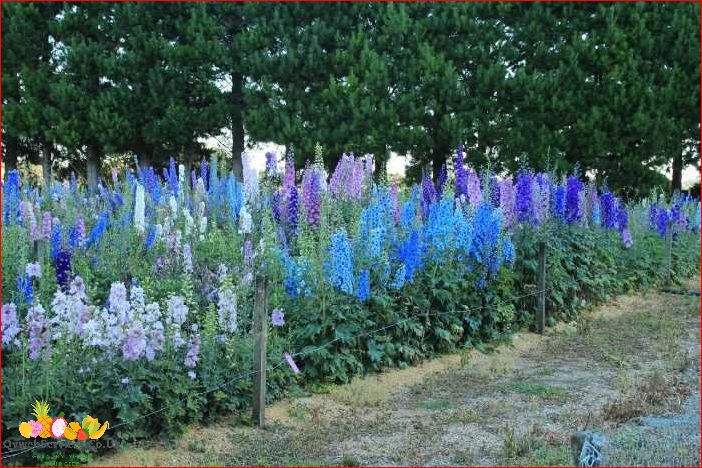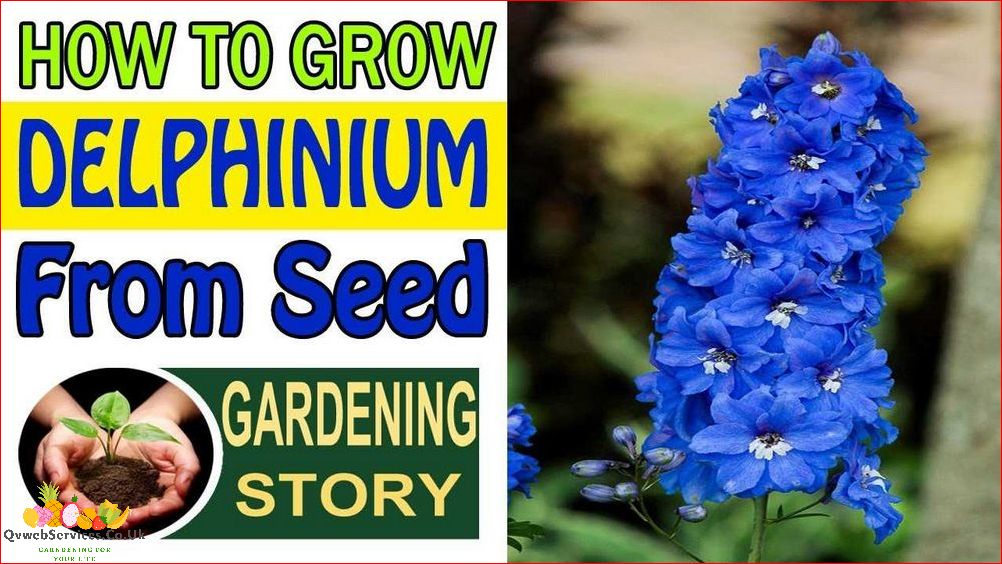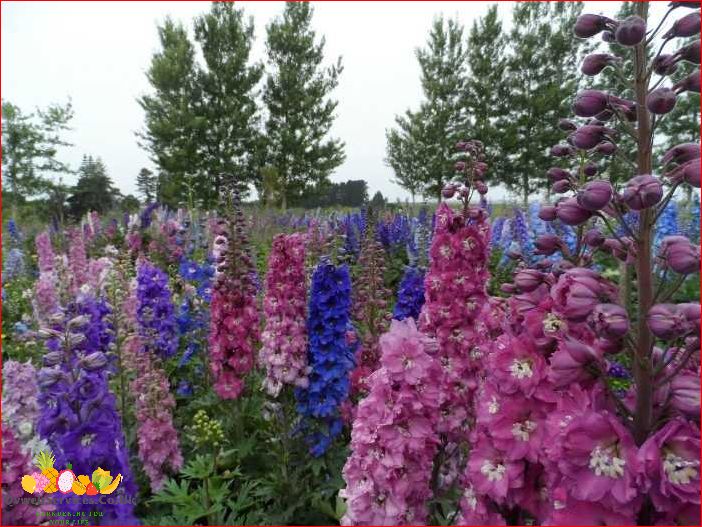Delphinium How to Grow from Seed

Delphiniums are beautiful and vibrant flowering plants that can add a touch of elegance to any garden. Growing delphiniums from seed is a rewarding and cost-effective way to enjoy these stunning flowers. Whether you are a seasoned gardener or a beginner, this article will guide you through the process of growing delphiniums from seed.
Step 1: Choosing the Right Seeds
When selecting delphinium seeds, it is important to choose a variety that is suitable for your climate and growing conditions. Delphiniums come in a wide range of colors and sizes, so you can choose the ones that best complement your garden. Look for seeds that are fresh and of high quality to ensure successful germination.
Step 2: Preparing the Soil
Delphiniums prefer well-draining soil that is rich in organic matter. Before planting the seeds, prepare the soil by removing any weeds and loosening it with a garden fork. Add compost or well-rotted manure to improve the soil’s fertility. It is also a good idea to test the soil’s pH level and adjust it if necessary.
Step 3: Sowing the Seeds
Sow the delphinium seeds in early spring or late summer, depending on your climate. Choose a sunny spot in your garden with at least six hours of direct sunlight per day. Scatter the seeds on the soil surface and lightly press them into the soil. Keep the soil moist but not waterlogged, as excessive moisture can cause the seeds to rot.
Step 4: Caring for Seedlings
Once the seeds have germinated, thin out the seedlings to ensure proper spacing. Delphiniums need enough space to grow and develop strong root systems. Water the seedlings regularly, especially during dry spells. Mulching around the plants can help retain moisture and suppress weeds. Provide support, such as stakes or trellises, to prevent the tall stems from bending or breaking.
Step 5: Protecting from Pests and Diseases
Delphiniums are susceptible to pests and diseases, such as aphids, slugs, and powdery mildew. Regularly inspect the plants for any signs of infestation or disease. Use organic pest control methods, such as handpicking pests or using insecticidal soap, to keep them at bay. Proper spacing and good air circulation can also help prevent the spread of diseases.
By following these steps, you can successfully grow delphiniums from seed and enjoy their stunning blooms in your garden. With proper care and attention, these beautiful flowers will thrive and become a focal point of your outdoor space.
Choosing the Right Seeds
Choosing the right seeds is an important step in successfully growing delphiniums from seed. Here are some factors to consider when selecting your seeds:
1. Variety

Delphiniums come in a variety of colors and sizes, so choose a variety that suits your preferences and garden space. Some popular varieties include ‘Pacific Giants’, ‘Magic Fountains’, and ‘Black Knight’.
2. Germination Rate
Check the germination rate of the seeds before purchasing. Look for seeds with a high germination rate to increase your chances of success. This information is usually provided on the seed packet.
3. Freshness
Choose fresh seeds to ensure better germination. Older seeds may have a lower germination rate, so it’s best to purchase seeds from a reputable supplier or collect fresh seeds from a reliable source.
4. Growing Conditions
Consider the growing conditions required by the specific delphinium variety you are interested in. Some varieties may prefer full sun, while others may tolerate partial shade. Make sure the growing conditions in your garden are suitable for the chosen variety.
5. Disease Resistance
Look for seeds that are resistant to common diseases that affect delphiniums, such as powdery mildew or crown rot. Disease-resistant varieties will have a better chance of thriving in your garden.
By considering these factors, you can choose the right delphinium seeds that will give you the best chance of successfully growing beautiful and healthy plants.
Preparing the Soil
Before planting delphinium seeds, it is important to prepare the soil properly. Delphiniums prefer well-draining soil that is rich in organic matter. Here are some steps to follow:
1. Choose the right location: Delphiniums thrive in full sun or partial shade. Select a spot in your garden that receives at least 6 hours of direct sunlight per day.
2. Clear the area: Remove any weeds, rocks, or debris from the planting area. This will help prevent competition for nutrients and ensure that the delphiniums have enough space to grow.
3. Loosen the soil: Use a garden fork or tiller to loosen the soil to a depth of at least 12 inches. This will improve drainage and allow the delphinium roots to penetrate the soil easily.
4. Amend the soil: Add organic matter such as compost or well-rotted manure to the soil. This will improve the soil structure, fertility, and water-holding capacity.
5. Test the soil: It is a good idea to test the soil pH and nutrient levels before planting. Delphiniums prefer a slightly acidic to neutral soil pH (around 6.0 to 7.0). Adjust the pH if necessary by adding lime or sulfur.
6. Mix in fertilizer: Before planting, mix in a slow-release fertilizer according to the package instructions. This will provide the delphiniums with the nutrients they need to grow strong and healthy.
7. Water the soil: Before sowing the delphinium seeds, water the soil thoroughly. This will ensure that the seeds have enough moisture to germinate and establish.
By following these steps, you can create the ideal growing conditions for your delphinium seeds and increase their chances of successful germination and growth.
Sowing the Seeds
Delphinium seeds can be sown directly into the garden or started indoors. If sowing directly into the garden, choose a sunny location with well-draining soil. Prepare the soil by removing any weeds and loosening it with a garden fork.
If starting indoors, fill a seed tray or small pots with a good quality seed starting mix. Moisten the mix before sowing the seeds. Delphinium seeds need light to germinate, so do not cover them with soil. Simply press the seeds lightly into the surface of the mix.
Keep the soil consistently moist but not waterlogged. Place the seed tray or pots in a warm location with indirect sunlight. Delphinium seeds typically take 2-3 weeks to germinate.
Once the seedlings have emerged, thin them out to allow for proper growth. Keep the strongest seedlings and remove any weak or overcrowded ones. Transplant the seedlings into larger pots or into the garden when they have reached a height of about 2-3 inches.
When transplanting into the garden, space the delphinium plants about 1-2 feet apart to allow for their tall growth habit. Water the plants regularly and provide support for the tall flower spikes, as they can become top-heavy and prone to bending or breaking.
With proper care and attention, your delphinium seeds will grow into beautiful, vibrant plants that will bring color and elegance to your garden.
Watering and Fertilizing
Proper watering and fertilizing are essential for the successful growth of delphiniums from seed. Here are some guidelines to follow:
Watering:
Delphiniums require consistent moisture, especially during their early growth stages. It is important to keep the soil evenly moist but not waterlogged. Overwatering can lead to root rot and other fungal diseases, while underwatering can cause the plants to wilt and stunt their growth.
Water the delphiniums deeply once or twice a week, depending on the weather conditions. During hot and dry periods, you may need to water more frequently. Be sure to water at the base of the plants to avoid wetting the foliage, as this can also contribute to disease development.
Fertilizing:
Delphiniums are heavy feeders and benefit from regular fertilization. Before planting the seeds, incorporate a balanced slow-release fertilizer into the soil. This will provide a steady supply of nutrients as the plants grow.
Once the delphiniums have established and started to grow, you can supplement with a liquid fertilizer every two to three weeks. Look for a fertilizer with a higher phosphorus content to promote strong root development and flower production.
Be careful not to over-fertilize, as this can lead to excessive foliage growth at the expense of flowers. Follow the instructions on the fertilizer packaging for the correct dosage and application method.
Remember to always water the delphiniums before applying fertilizer to avoid burning the roots.
By providing adequate water and nutrients, you can ensure healthy and vibrant delphinium plants that will reward you with beautiful blooms.
Protecting the Seeds
After sowing the delphinium seeds, it is important to protect them from potential threats that can hinder their growth. Here are some measures you can take to ensure the safety of your delphinium seeds:
1. Mulching
Applying a layer of mulch around the seeded area can help to retain moisture in the soil and regulate its temperature. This can create a favorable environment for the seeds to germinate and grow. Use organic mulch, such as straw or shredded leaves, and spread it evenly around the seeds.
2. Pest Control
Delphinium seeds can be vulnerable to pests, such as slugs and snails, which can feed on the young seedlings. To protect the seeds, you can use organic pest control methods, such as placing copper tape around the seeded area or using natural repellents like crushed eggshells or diatomaceous earth.
Additionally, keep an eye out for any signs of pest damage and take immediate action to prevent further harm to the seeds.
3. Bird Protection
Birds can be attracted to the delphinium seeds, mistaking them for food. To prevent birds from eating the seeds, you can cover the seeded area with a fine mesh or bird netting. This will allow air and sunlight to reach the seeds while keeping the birds away.
Remember to regularly check the mesh or netting for any damage or gaps that may allow birds to access the seeds.
By taking these protective measures, you can increase the chances of successful germination and growth for your delphinium seeds. With proper care and attention, you will soon be rewarded with beautiful and vibrant delphinium flowers in your garden.
Transplanting Seedlings
Once your delphinium seedlings have grown to a height of about 2-3 inches and have developed a few sets of true leaves, they are ready to be transplanted into larger containers or directly into the garden.
Before transplanting, make sure to prepare the new containers or garden bed by loosening the soil and adding some organic matter, such as compost or well-rotted manure, to improve drainage and fertility.
To transplant the seedlings, gently loosen the soil around each plant with a small garden trowel or fork. Carefully lift the seedlings, taking care not to damage the roots, and place them into the prepared containers or garden bed at the same depth they were previously growing.
Space the transplanted seedlings about 12-18 inches apart to allow for proper air circulation and growth. Water the newly transplanted seedlings thoroughly to help settle the soil and reduce transplant shock.
It is important to protect the transplanted seedlings from extreme weather conditions, such as strong winds or heavy rain, for the first few days after transplanting. You can use a temporary shade cloth or a cloche to provide some protection until the seedlings become established.
Continue to water the transplanted seedlings regularly, keeping the soil evenly moist but not waterlogged. Gradually increase the amount of sunlight the seedlings receive by exposing them to a few hours of direct sunlight each day.
With proper care and attention, your transplanted delphinium seedlings will continue to grow and thrive, eventually producing beautiful blooms that will brighten up your garden.
Providing Support for Growth
Delphiniums are tall plants that can reach heights of up to 6 feet or more. As they grow, they may require support to prevent them from falling over or breaking under their own weight. Providing support for your delphiniums will help them grow straight and strong, and will also enhance their overall appearance in your garden.
There are several methods you can use to provide support for your delphiniums. One common method is to use stakes or bamboo canes. Place the stakes or canes around the base of the plant, and gently tie the stems to the support using garden twine. Be careful not to tie the twine too tightly, as this can damage the stems.
Another option is to use a plant support ring or cage. These are typically made of metal or plastic, and can be placed around the delphinium plant to provide support from all sides. The plant will grow through the gaps in the support, and the ring or cage will help to keep it upright.
If you prefer a more natural look, you can also use nearby plants or shrubs to provide support for your delphiniums. Planting them near taller plants or shrubs will give them something to lean on as they grow.
Regardless of the method you choose, it’s important to provide support for your delphiniums early on in their growth. As they mature, their stems become more rigid and are less likely to bend or break. However, if you wait too long to provide support, it may be more difficult to do so without damaging the plant.
By providing support for your delphiniums, you can ensure that they grow straight and strong, and that they reach their full potential in your garden.
| Methods of Providing Support for Delphiniums |
|---|
| Stakes or bamboo canes |
| Plant support rings or cages |
| Using nearby plants or shrubs |
Pruning and Deadheading
Pruning and deadheading are important tasks when it comes to growing delphiniums from seed. Pruning helps maintain the shape and size of the plant, while deadheading encourages continuous blooming and prevents the plant from going to seed too quickly.
Pruning
Pruning delphiniums is best done in early spring, before new growth begins. Start by removing any dead or damaged stems, cutting them back to the base of the plant. This will help improve the overall appearance of the plant and prevent the spread of diseases.
Next, thin out the remaining stems to create a more open and airy plant. This will allow for better air circulation and reduce the risk of powdery mildew. Cut back the stems to just above a set of healthy leaves or buds.
If your delphiniums have become leggy or floppy, you can also cut them back by one-third to one-half of their height. This will help promote bushier growth and prevent them from toppling over.
Deadheading
Deadheading is the process of removing spent flowers from the plant. This not only improves the appearance of the delphiniums but also encourages the production of more blooms.
To deadhead delphiniums, simply cut off the flower stalks just above a set of healthy leaves or buds. This will redirect the plant’s energy towards producing new flowers instead of setting seeds.
Regular deadheading throughout the blooming season will help prolong the flowering period and keep your delphiniums looking their best. Be sure to remove any faded or wilted flowers promptly to prevent the plant from self-seeding and spreading.
| Pruning | Deadheading |
|---|---|
| Remove dead or damaged stems | Cut off spent flowers just above healthy leaves or buds |
| Thin out remaining stems for better air circulation | Promotes continuous blooming |
| Cut back leggy or floppy stems | Prevents self-seeding |
Dealing with Pests and Diseases
Delphiniums are generally hardy plants, but they can still be susceptible to certain pests and diseases. Here are some common issues to watch out for and how to deal with them:
Pests
1. Aphids: These small insects can be found on the undersides of leaves and can cause damage by sucking sap from the plant. To control aphids, you can spray the plant with a mixture of water and dish soap or use insecticidal soap.
2. Slugs and snails: These slimy creatures can eat through the leaves and stems of delphiniums. To prevent slug and snail damage, you can use organic slug pellets or create barriers around the plants using copper tape.
3. Thrips: Thrips are tiny insects that can cause discoloration and distortion of the leaves. To control thrips, you can use insecticidal soap or introduce beneficial insects like ladybugs or lacewings.
Diseases
1. Powdery mildew: Powdery mildew is a fungal disease that can cause a white powdery coating on the leaves. To prevent powdery mildew, make sure to provide good air circulation around the plants and avoid overhead watering. If powdery mildew does occur, you can treat it with a fungicide.
2. Crown rot: Crown rot is a fungal disease that affects the base of the plant, causing it to rot. To prevent crown rot, make sure the soil is well-drained and avoid overwatering. If crown rot occurs, remove and destroy the affected plants to prevent the spread of the disease.
3. Leaf spot: Leaf spot is a fungal disease that causes dark spots on the leaves. To prevent leaf spot, avoid overhead watering and provide good air circulation. If leaf spot occurs, remove and destroy the affected leaves and treat the plant with a fungicide.
By being vigilant and taking appropriate action, you can keep your delphiniums healthy and free from pests and diseases. Regularly inspect your plants and take prompt action if you notice any signs of trouble.
Harvesting Delphinium Seeds
Harvesting delphinium seeds is an important step in the process of growing these beautiful flowers. By collecting and saving the seeds, you can ensure a continuous supply of delphiniums for your garden. Here are some tips on how to harvest delphinium seeds:
- Wait for the delphinium flowers to fade and dry up on the plant. The petals will fall off, and the seed pods will start to form.
- Check the seed pods regularly to see if they have turned brown and dried out. This is a sign that the seeds are ready for harvesting.
- Use a pair of scissors or pruners to cut the seed pods from the plant. Make sure to leave a small stem attached to the seed pod for easier handling.
- Place the seed pods in a paper bag or envelope. Label the bag with the name and date of the delphinium variety.
- Store the bag in a cool, dry place for a few weeks to allow the seeds to fully dry out.
- Once the seeds are dry, gently crush the seed pods to release the seeds. Be careful not to damage the seeds in the process.
- Remove any debris or chaff from the seeds by gently blowing on them or using a fine sieve.
- Store the delphinium seeds in a cool, dry place in a labeled envelope or container until you are ready to plant them.
By following these steps, you can successfully harvest and save delphinium seeds for future planting. Remember to store the seeds properly to ensure their viability and enjoy the beauty of delphiniums in your garden year after year.
Storing Delphinium Seeds
After collecting delphinium seeds, it is important to store them properly to ensure their viability for future planting. Here are some steps to follow:
Cleaning the Seeds

Before storing the seeds, it is important to clean them to remove any debris or plant material. This can be done by gently rubbing the seeds between your fingers or using a sieve to separate the seeds from the chaff.
Drying the Seeds
Once the seeds are clean, they should be dried thoroughly before storage. Spread the seeds out in a single layer on a clean, dry surface, such as a paper towel or a tray lined with parchment paper. Allow the seeds to air dry for several days, until they are completely dry and no longer feel moist to the touch.
Choosing a Storage Container
When it comes to storing delphinium seeds, it is important to choose a container that is airtight and moisture-proof. This will help to prevent moisture from getting in and causing the seeds to mold or rot. Good options for storage containers include glass jars with tight-fitting lids or sealed plastic bags.
Labeling and Dating
Before storing the seeds, it is important to label them with the variety and the date of collection. This will help you keep track of the seeds and ensure that you use the oldest seeds first.
Storing the Seeds
Place the dried and labeled delphinium seeds in the chosen storage container. Make sure to seal the container tightly to prevent any moisture or air from entering. Store the container in a cool, dry place, such as a refrigerator or a cool basement. The ideal temperature for storing delphinium seeds is around 40°F (4°C).
By following these steps, you can ensure that your delphinium seeds remain viable and ready for planting when the time comes.
Propagating Delphinium from Cuttings
Propagating delphinium from cuttings is another method to grow these beautiful flowers. This technique is useful if you want to create new plants that are genetically identical to the parent plant. Here are the steps to propagate delphinium from cuttings:
1. Select a healthy delphinium plant with strong stems and vibrant flowers. It’s best to take cuttings in early summer when the plant is actively growing.
2. Prepare a clean, sharp knife or pair of garden shears. Sterilize the cutting tool with rubbing alcohol or a mixture of bleach and water to prevent the spread of diseases.
3. Choose a non-flowering stem that is about 4-6 inches long. Make a clean cut just below a leaf node, which is where the leaves attach to the stem.
4. Remove the lower leaves from the cutting, leaving only a few leaves at the top. This will reduce water loss and help the cutting establish roots more easily.
5. Dip the cut end of the stem into a rooting hormone powder. This will encourage root growth and increase the chances of successful propagation.
6. Fill a small pot or seed tray with a well-draining potting mix. Make a hole in the soil with a pencil or your finger, and gently insert the cutting into the hole. Firmly press the soil around the stem to ensure good contact.
7. Water the cutting thoroughly, making sure the soil is evenly moist. Place the pot or tray in a warm, bright location, but away from direct sunlight. A greenhouse or a sunny windowsill are good options.
8. Keep the soil consistently moist, but not waterlogged. Mist the cutting with water to maintain humidity, especially in dry environments.
9. After a few weeks, the cutting should start developing roots. You can gently tug on the stem to check for resistance, which indicates root growth.
10. Once the cutting has established a good root system, you can transplant it into a larger pot or directly into the garden. Make sure to harden off the new plant by gradually exposing it to outdoor conditions.
By following these steps, you can successfully propagate delphinium from cuttings and enjoy a beautiful display of these stunning flowers in your garden.
Overwintering Delphinium Plants
Delphinium plants are not frost-tolerant and need protection during the winter months. Here are some steps to help you overwinter your delphinium plants:
- Cut back the foliage: Before the first frost, cut back the foliage of the delphinium plants to about 2-3 inches above the ground. This will help prevent the plants from becoming too top-heavy and reduce the risk of wind damage during the winter.
- Protect the crown: After cutting back the foliage, cover the crown of the delphinium plants with a layer of mulch. This will help insulate the crown and protect it from freezing temperatures.
- Provide additional insulation: In areas with harsh winter conditions, you may need to provide additional insulation for your delphinium plants. One option is to use a layer of straw or pine needles around the base of the plants. Another option is to use a protective covering, such as a frost blanket or burlap, to shield the plants from cold winds and frost.
- Monitor moisture levels: During the winter, it’s important to monitor the moisture levels around your delphinium plants. While they don’t need as much water as during the growing season, they should not be allowed to dry out completely. Check the soil regularly and water as needed to keep it slightly moist.
- Remove winter protection in spring: As the weather begins to warm up in spring, gradually remove the winter protection from your delphinium plants. Start by removing the mulch and any other insulation, and then monitor the plants for new growth. Once new growth appears, you can remove any remaining dead foliage or stems.
By following these steps, you can help ensure that your delphinium plants survive the winter and continue to thrive in your garden for years to come.
Common Delphinium Varieties
Delphiniums are a popular choice for gardeners due to their tall spires of colorful flowers. There are several common varieties of delphiniums that you can choose from to add beauty to your garden. Here are a few popular options:
1. Pacific Giants

Pacific Giants are one of the most popular varieties of delphiniums. They are known for their large, showy flowers that come in a range of colors, including blue, purple, pink, and white. These delphiniums can grow up to 6 feet tall and make a stunning addition to any garden.
2. Belladonna
Belladonna delphiniums are another popular choice. They are known for their delicate, pastel-colored flowers that bloom in early summer. These delphiniums are shorter than the Pacific Giants, typically reaching heights of 3 to 4 feet. They are perfect for adding a touch of elegance to your garden.
3. Magic Fountains
Magic Fountains delphiniums are a dwarf variety that is perfect for smaller gardens or containers. They have shorter flower spikes, usually around 2 to 3 feet tall, but still produce a profusion of beautiful flowers. Magic Fountains delphiniums are available in a variety of colors, including blue, pink, and white.
These are just a few examples of the many delphinium varieties available. When choosing a delphinium for your garden, consider factors such as height, flower color, and bloom time to ensure that you select the perfect variety for your space.
| Variety | Height | Flower Color |
|---|---|---|
| Pacific Giants | Up to 6 feet | Blue, purple, pink, white |
| Belladonna | 3 to 4 feet | Pastel colors |
| Magic Fountains | 2 to 3 feet | Blue, pink, white |
Video:Delphinium How to Grow from Seed
HOW TO GROW LARKSPUR FROM SEED: A BEAUTIFUL NEST TV
As Stephanie C. Phillips, I am the voice and green thumb behind QvWebServices.co.uk. My passion for gardening and sharing my knowledge with others has led me to create a space where fellow gardening enthusiasts can find practical advice and inspiration.
From the sun-soaked fields of Texas to the cozy balconies of city dwellers, I strive to guide you through the nuances of growing your own food and beautifying your surroundings with plants. My articles are a reflection of my dedication to the art of gardening, and I hope they encourage you to get your hands dirty and enjoy the rewards of nurturing life from the soil.
Join me on this verdant journey to cultivate not just gardens, but a sense of community and connection to the earth.

